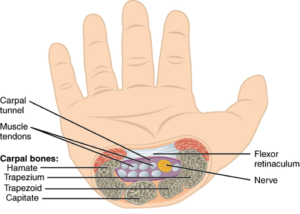
Carpal Tunnel Release Surgery helps to relieve the pressure on the median nerve in the wrist, alleviating pain and numbness.
What is it?
Some small bones and tendons surround the median nerve in the wrist. When these tendons become inflamed and swell, they put pressure on the median nerve and cause pain and numbness in the hand/wrist. This condition is called Carpal Tunnel Syndrome. Carpal Tunnel Release Surgery helps to relieve the pressure on the median nerve and restore function and mobility in the hand and wrist. Surgical intervention may prevent permanent damage to the median nerve, as well as alleviate pain.
What should I do to prepare?
Preparing for any surgery can be stressful. It is best to understand and talk with your doctor about what will happen during the surgery and what to expect after it is complete. Having a family member or close friend with you the day of surgery can help alleviate some stress. Scans and preoperative testing will be conducted to determine the best approach to relieving the pressure on the median nerve. A patient should not eat or drink after the midnight before surgery. Rest and immobilization may be necessary post-surgery to help in the healing process. This may require time off from work and other physical activities.
What happens during the process?
Carpal Tunnel Release Surgery can be done two ways; as an arthroscopic surgery or as an open surgery. The patient will be unconscious, and the surgeon will make an incision in the palm of the hand, or use small incisions for the arthroscopic method, to access the Carpal Tunnel. The Transverse Carpal Ligament will be cut to give more room for the median nerve and to relieve the built up pressure. This ligament will typically heal and reattach by itself, but leave enough space for the median nerve to work properly.
What are the risks and possible complications?
Any surgery involving bones, muscles, or tendons will pose a risk for re-injury or injury to another part of the surrounding area. Infections, bleeding, and numbness or tingling are possible with this surgery. Weakness and loss of function are also a possibility with Carpal Tunnel Release Surgery. There is also the chance that there will be damage to blood vessels and nerves within the hand and wrist. There is the chance that further surgery may need to be done later down the road to correct any reoccurrence.
Disclaimer:
All GlobeHealer Site content, including graphics, images, logos, and text, among other materials on the site are only for education purposes. This content is not intended to be a substitute for professional medical advice, and you should always contact your physician or qualified health provider for information regarding your health. Information on this site regarding the overview, diagnosis, and treatment of any kind should be looked at, in addition to the advice and information of your health care professional. Do not disregard medical advice or delay seeking treatment or medical advice due to information found on the GlobeHealer site.
If there is even the possibility that you may have a medical emergency, seek treatment, call your doctor, or call your local emergency telephone number immediately. GlobeHealer does not endorse being the first line of communication in case of emergency and does not endorse any specific test, physician, facility, product, procedure, opinion, or other information that is or may be mentioned on this site or affiliated entities. Reliance of any and all information provided by GlobeHealer, its employees, affiliations, others appearing on the Site under the invitation of GlobeHealer, or visitors of the site is solely at your own risk and is not the responsibility of GlobeHealer.
Image Source:
https://upload.wikimedia.org/wikipedia/commons/c/c9/815_The_Carpal_Tunnel.jpg
